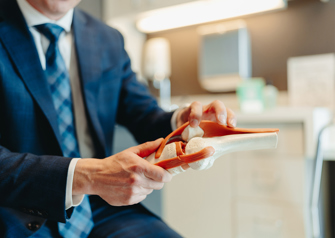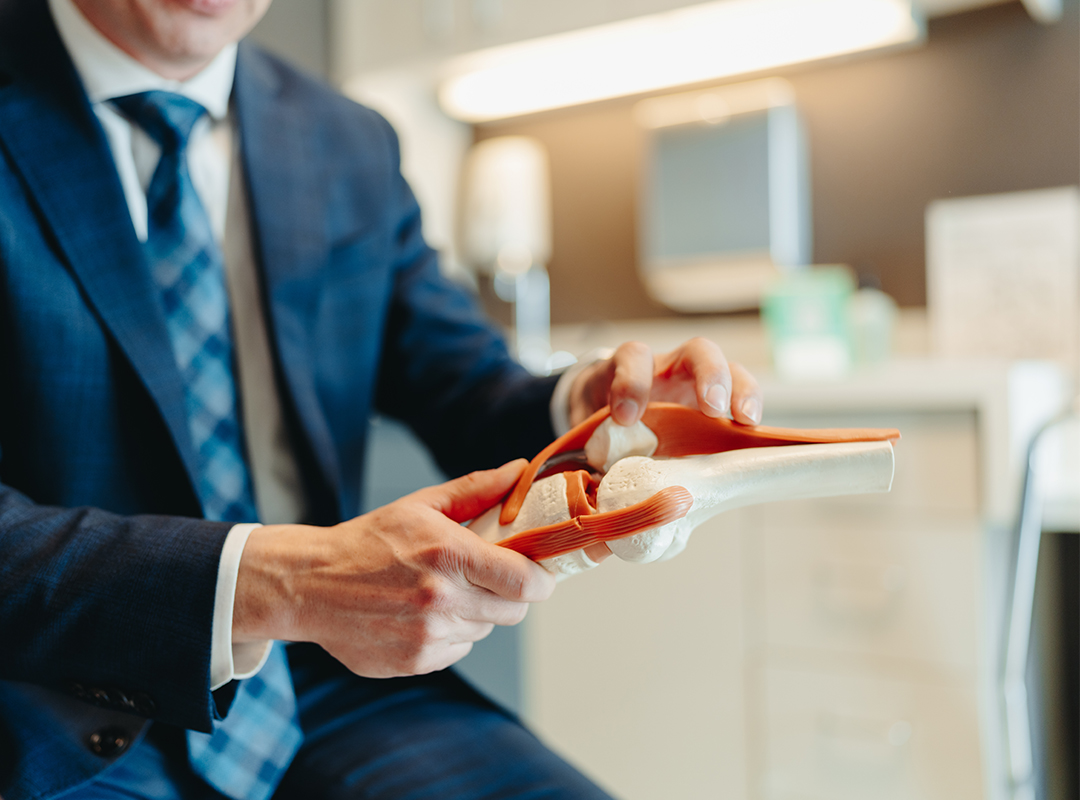
News
Meniscus and ACL injuries in the same knee
Date posted: 12/28/2023
Last updated: 12/28/2023
Table of Contents

Q: Can ACL and meniscus injuries simultaneously occur in the same knee?
A: Certainly. ACL and meniscus injuries co-occurring is not only possible but also a frequent event. Both components are crucial to the knee's function and stability.
The ACL, one of the major ligaments in the knee, primarily provides rotational stability and provides good movement between the tibia and femur. The menisci, on the other hand, are two crescent-shaped cartilages situated between the femur and tibia. They help the joint fit together, act as shock absorbers, and assist in knee stability.
In the intricate biomechanics of the knee, the ACL and menisci work cooperatively, so that an injury to one often has implications for the other. For instance, a powerful twist might stress the ACL beyond its limit, and the same rotational movement could also put undue pressure on the meniscus, leading to tears in both structures. Also, when one of them is compromised, it can subsequently alter the dynamics of the knee, increasing the vulnerability of other components.
Not only can ACL and meniscus injuries occur simultaneously, but they often do. In traumatic knee injuries, especially those involving sudden twisting motions or direct impacts, multiple structures within the knee can be affected at once. It's not uncommon for an athlete or individual to tear their ACL and damage one or both of their menisci in a single unfortunate incident.
When faced with such dual injuries, doctors often opt for a comprehensive approach to tackling both injuries in a single surgical intervention. Through new techniques and innovative devices, meniscal repair outcomes have significantly improved, and we are now able to repair most meniscus tears without having to remove any tissue. Recovery and rehabilitation following such surgeries are crucial to restore optimal knee functionality and prevent future complications.
Q: What are the most common causes of ACL and meniscus injuries?
A: ACL and meniscus injuries, commonly seen in orthopedic and sports medicine contexts, have several root causes stemming from both external and internal factors. A significant cause of these injuries is related to the biomechanical stresses the knee encounters during certain activities. Rapid directional shifts, sudden halts, or direct impacts to the knee are movements that exert tremendous stress on the knee structures. These sudden actions can stretch and strain the ligaments and cartilage beyond their natural elasticity, leading to tears in the ACL, meniscus, or both
Particular sports exhibit a higher propensity for such injuries due to the nature of their gameplay. Soccer players, for example, frequently engage in quick pivoting and abrupt stops. Basketball demands rapid direction changes, while football has a combination of sprints, stops, and direct collisions. Skiing, with its downhill speed and potential for falls, can also be a catalyst for knee injuries.
Beyond these immediate physical causes, several risk factors can heighten the likelihood of these injuries. Inadequate conditioning can render the muscles around the knee weaker, offering less support and protection. Flawed techniques, especially in sports, can lead to compromised knee positions during action. Furthermore, equipment malfunction, such as poorly fitted footwear or damaged ski bindings, can introduce unforeseen stresses to the knee.
It's important to note the role of age and degenerative factors. As individuals age, their ligaments and cartilage naturally wear down and lose elasticity. This degeneration, compounded with reduced muscle strength, makes the older population more susceptible to ACL and meniscus injuries, even from minor stresses.
Q: Can ACL and meniscus injuries predispose one to long-term knee complications?
A: Absolutely. ACL and meniscus injuries, if not appropriately managed, can predispose an individual to a variety of long-term knee complications.
One of the most prominent issues stemming from these injuries is persistent knee joint instability. The ACL, in tandem with the meniscus, plays a pivotal role in ensuring that the knee maintains its structural and functional integrity. When either or both of these components are damaged, the knee can lose its natural ability to stabilize, leading to a sensation of the knee "giving way" during specific movements or activities.
In addition to instability, injuries to the ACL or meniscus can have a cascading effect, jeopardizing other knee structures. With altered biomechanics due to a torn ACL or meniscus, undue strain can be exerted on other ligaments, the remaining meniscal tissue, and even the articular cartilage. Over time, this can culminate in compounded damage, causing further functional impairments and exacerbating pain.
Enduring pain and swelling are also common sequelae of these injuries. Chronic inflammation can be a persistent issue, often signifying ongoing tissue damage or irritation. This chronic pain and inflammation can severely hamper an individual's mobility and quality of life.
Perhaps one of the most concerning long-term complications linked to ACL and meniscus injuries is the potential for early-onset osteoarthritis. The disruption of the knee's natural biomechanics and direct damage to the articular cartilage can accelerate the degenerative processes. Consequently, the knee can become arthritic much earlier than expected, leading to pain, stiffness, and decreased range of motion. Addressing these injuries surgically has been demonstrated to lessen the occurrence or degree of these degenerative changes.
Q: What complications might arise from ACL and meniscus surgeries?
A: ACL and meniscus surgeries are routine procedures that, when conducted by experienced surgeons, have a notably high success rate. However, there is still a small risk of potential complications.
Infections are immediate concerns post-surgery, as surgical incisions might become entry points for bacteria. Stiffness, resulting from swelling, scar tissue, or prolonged immobilization, can limit the knee's range of motion. Blood clot formation, or deep vein thrombosis, is a serious risk due to post-surgery immobility. Rarely, the surrounding nerve network might be affected, causing numbness or weakness.
Specific to ACL reconstruction, complications like graft integration issues can arise. Moreover, donor site pain (from where the graft was taken from) can occur.
In the vast majority of cases, patients experience successful outcomes, with many returning to their pre-injury levels of activity. The emphasis during the post-operative phase on guided rehabilitation and proper care further mitigates the risks of complications.
